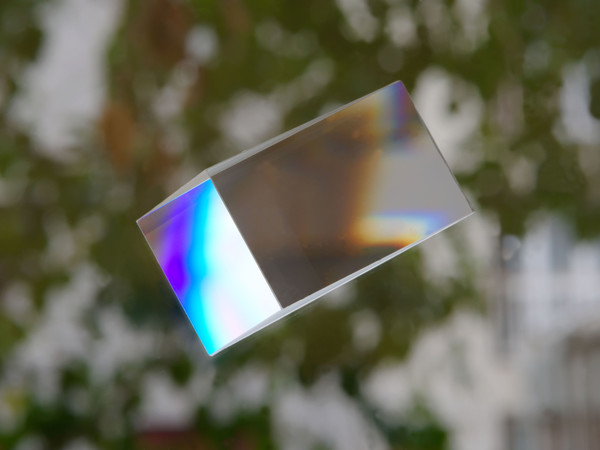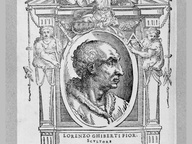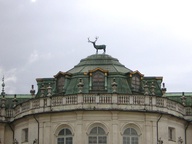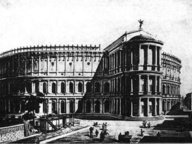Ann Veronica Janssens. Grand Bal

© 2023 Ann Veronica Janssens / SIAE | Ann Veronica Janssens, Untitled (Prism), 2013. Courtesy l’artista e Institut d’Art Contemporain, Villeurbanne/Rhône-Alpes I Ph. Blaise Adilon
From 05 Aprile 2023 to 30 Luglio 2023
Milan
Place: Pirelli HangarBicocca
Address: Via Chiese 2
Times: Thursday, Friday, Saturday and Sunday 10.30 AM – 8.30 PM
Responsibles: Roberta Tenconi
Ticket price: Free, reservation required
Telefono per informazioni: +39 02 6611 1573
E-Mail info: info@hangarbicocca.org
Official site: http://pirellihangarbicocca.org
Pirelli HangarBicocca presents a retrospective of the work of Belgian artist Ann Veronica Janssens, one of the world’s foremost artists. Throughout her 40-year career, Janssens has continued to experiment with light, her primary material. She has investigated the sensory and performative nature of space and architecture, creating works that are mutable and ephemeral.
Emerging from her research, the artist's interventions are set on the border between art and science, and investigate the limits of human perception and psyche, as well as the aleatory connotations of natural phenomena, down to their minimum scale.
"Grand Bal" is conceived as an extended choreography that situates environmental installations alongside more intimate works, tracing a visual, aural and tactile path that invites visitors to move between the incorporeal, the tangible and between surreal atmospheres and the socio-political and cultural signs of our present time.
Since the late 1970s, Ann Veronica Janssens (Folkestone, UK, 1956; lives and works in Brussels) has developed her research around light and its relationship to what surrounds it, often creating site- specific works that challenge the immutable nature of sculpture and installation. Frequently associated with the work of "Light & Space"—the 1960s group of American artists that included, among others, Robert Irwin and James Turrell—Janssens has built her practice on overcoming the art object through its dematerialization and deconstruction. Through minimal forms and gestures that have an anti- monumental quality, Janssens is actually able to change the public's perception of space. With their use of light, color, mirrors, air or artificial fog, the works of Janssens call for the direct participation of viewers, inviting them to experience reality differently, to develop an awareness of their senses, of the architecture and spatial-temporal categories by which we define it, emphasizing its sociopolitical and cultural aspects. Often based on experiments carried out in collaboration with scientists, the artist's works become labs for testing the boundaries between properties and physical-material elements that are regarded as opposites, such as light and darkness, sound and silence, emptiness and presence, the tangible and the incorporeal.
"Grand Bal," curated by Roberta Tenconi, explores the career of Ann Veronica Janssens as well as different aspects of her practice. Presenting the most comprehensive selection of her works to date, it includes both historical projects and new productions designed to interact with the space of the Navate within Pirelli HangarBicocca and the outdoor area, expanding its boundaries. To do this, the artist has come up with an unprecedented intervention, waves (2023), in which she transforms some of the exit doors into openings: by replacing the doors with a porous, transparent PVC net, she allows natural light, as well as sounds, air and other external elements, to penetrate into the exhibition space. The resulting alterations fit dynamically within the exhibition plan, conceived by the artist as a visual and sound choreography that centers not so much on objects as on visitors: they are called upon to move and participate directly, following the train of sensations and perceptions generated while experiencing the works. The title "Grand Bal" (grand ball in French) evokes precisely this performative dimension, and the dynamic relationship that is established between works, architecture and the human body as in a dance, where each and every element is necessary for the other to reveal itself completely.
This connection is already evident in the first installation that opens the exhibition, Drops (1999/2023), presented at the entrance to the Navate. Twelve round mirrors, arranged on the floor of the Piazza, reflect drop-like fragments and details of the building's architectural structure, troubling the visitor’s perception of the site and offering new visual perspectives on the surroundings. The mirror elements react in ever-changing ways to the conditions of the place in which they are displayed, altering them in their turn through the refraction of light. This work is a new version of Danaé (1999), created in collaboration with Nord project and Co in the Scuola Grande di San Rocco in Venice, in which mirrors on the ground interacted with, and reflected, the image of Tintoretto's (1518-1594) ceiling frescoes, generating multiple connections between space, the works, artists and visitors. Alongside art history, the history of architecture also plays a fundamental role for Ann Veronica Janssens, as can be seen in the video Oscar (2009) exhibited at Pirelli HangarBicocca, focusing on architect Oscar Niemeyer (1907-2012), master of Brazilian modernism and radical spokesman for social ideals. Many of the artist’s works question the meaning of architecture, redefining the features of buildings and public spaces. For example, in Area (1978-2023), a section of the Navate is altered by a large walkable surface composed of bricks, a space within a space that also houses other works. With this installation, Janssens questions the canonical definitions of sculpture and architecture, creating what she calls a super space: "a spatial extension of an existing architecture... I often experiment with ways of making the perception of matter and architecture fluid, which I see as a kind of obstacle to movement and to sculpture" (Ann Veronica Janssens, 2004). Some swings suspended above the bricks make up the work Swings (2000-2023). Visitors are invited to use these elements, associated with childhood and play and designed for the outdoors, which adds a sense of disorientation to the exhibition's experience. The dissonance between the swings and the enclosed space makes visitors aware of their own movement and of the air displacement caused by the rocking motion. The seats are also covered with a heat-reactive film that changes hue upon contact with warmth: the presence of the human body temporarily changes the appearance of the work, leaving an ephemeral trace of its passage.
Ann Veronica Janssens also explores the dissolution of space itself through sensory and perceptual interventions. L'espace infini (1999), a hollow rectangular structure that has no corners or edges, confronts visitors with a completely white environment, in which an optical effect prevents the eye from discerning dimensions and borders, causing a sense of vertigo and infinity. Similarly, the installation that closes the exhibition in the Cubo space, MUKHA Anvers (1997/2023), also produces similar results. In this case, the artist uses a dense artificial fog and natural light to dissolve and blur the features of the room and the presence of bodies, even as she makes more visible the physical and material qualities of the air in a seemingly empty environment. This exploration of the concepts of the tangible and intangible leads the artist to make use of color, fog, and light predominantly, as is the case in Rouge 106 -Bleu 132 (Scale Model) (2003-2007). Here the audience finds itself in an iridescent environment and, thanks to the presence of flashing blue and red lights, experiences a new vision of the color white. In Bitter, Salty, Acid and Sweet (2019), Janssens again investigates the abstract qualities of color, using two large beams of artificial light, which move through the space out of sync, without ever being able to overlap, in an illusory, immaterial pursuit that creates a sense of tension.
Janssens’ her investigation of the sculptural dimension of light and color leads her to experiment with the accidental connotations of natural phenomena, down to the microscopic scale. Untitled (Prism) (2013), in its apparent simplicity, is formed by a small crystal prism placed on a sheet of glass captures light, whose colored reflections are manifested within the form. The artist says about the work, "Mymain material is light. I use it in all shapes, liquid, solid, gaseous... as a reflection... It’s a bit like a kind of evidence of a radiation that occurs, a radiation that...allows me to show the manifestations of reality in a different way [...] I work a lot by subtraction. There are quite simple shapes, simple propositions... it’s a kind of I remove, I remove, I decrease, I try to go towards the minimum” (Ann Veronica Janssens, 2016).
Public Program
Saturday 15 and Sunday 16 April Pirelli HangarBicocca presents the Public Program devoted to Ann Veronica Janssens’ solo show “Grand Bal,” with an event featuring a choreography created and danced by Anne Teresa De Keersmaeker, entitled Pioverà.
The catalogue
"Grand Bal" is complemented by a companion monograph that explores the themes addressed in Ann Veronica Janssens' work, providing new perspectives on her practice. Designed by Manuela Dechames Otamendi and published by Pirelli HangarBicocca with Marsilio publishers in English and Italian, the catalogue includes critical texts and thematic insights that analyze the artist’s body of workfrom the point of view of different fields, including architecture, philosophy, fiction and art history, as well as a conversation between the artist and the curator of the show, Roberta Tenconi. The invited contributors are: Philippe Bertels, Robin Clark, Kersteen Geers and Jelena Pančevac, Stéphane Ibars, Maud Hagelstein, and Ernst van Alphen. The catalogue will be available by May 2023.
Ann Veronica Janssens
Ann Veronica Janssens' work has been featured in solo exhibitions at institutions of international importance, including Louisiana Museum of Modern Art Humlebæk and South London Gallery (2020); Musée de l'Orangerie, Paris (2019); Baltimore Museum of Art, De Pont, Tilburg, Kiasma Museum of Contemporary Art, Helsinki (2018); IAC – Institut d'art contemporain – Villeurbanne/Rhône-Alpes (2017); Nasher Sculpture Center, Dallas (2016); Wellcome Collection, London (2015); Ausstellungshalle Zeitgenössiche Kunst, Münster, CRAC Alsace - centre rhénan d'art contemporain, Altkirch (2011); WIELS, Brussels, Espai d'Art Contemporani de Castellò, Castellón (2009); Museum Mosbroich, Leverkusen (2007); Kunsthalle Bern, Bern, Musée d'Orsay, Paris, CCAC Wattis Institute for Contemporary Arts, San Francisco (2003); Neue Nationalgalerie, Berlin (2001). The artist has participated in major international exhibitions—including Sharjah Biennial 14 (2019); Manifesta 10, St. Petersburg (2014); Biennale of Sydney (1998 and 2012); Biennale de Lyon (2005); and Bienal de São Paulo (1994)—as well as group exhibitions in institutions such as Kunsthalle Wien, Vienna; SMAK, Ghent; Grand Palais, Paris; Punta della Dogana, Venice (2019); Hayward Gallery, London (2018); Mudam, Luxembourg, Sprengel Museum, Hannover, Museo de Arte Contemporáneo, Buenos Aires (2015); Palais de Tokyo, Paris (2014); Fundació Juan Miró, Barcelona (2013). In 1999 she represented Belgium (with Michel François) at the 48th Venice Biennale.
Roberta Tenconi
Roberta Tenconi is Chief Curator at Pirelli HangarBicocca in Milan. Previously she was part of the curatorial team of the 55th Venice Biennale “The Encyclopedic Palace” (2013), the 4th Berlin Biennale (2006) and Fondazione Nicola Trussardi, Milan (2006-2015).
The exhibition program
"Grand Bal" is part of the art program conceived by Artistic Director Vicente Todolí in collaboration with the curatorial department: Roberta Tenconi, Chief Curator; Lucia Aspesi, Curator; Fiammetta Griccioli, Curator. In addition to Ann Veronica Janssens’ solo show, the 2023 program includes, in the Navate space, the exhibition James Lee Byars (12 October 2023 to 18 February 2024). In the Shed space, Gian Maria Tosatti’s solo show (until 30 July 2023) and the exhibition by Thao Nguyen Phan (14 September 2023 to 14 January 2024).
Pirelli HangarBicocca
Pirelli HangarBicocca an institution founded in 2004, was relaunched in 2012 by Pirelli, which has been a founding partner since its inception. In recent years the exhibition space has consolidated its role as an art center, attracting an international audience with shows that stand out for their high curatorial standards and great visual impact, and thanks to its offer of unique exhibition projects. The spaces of Pirelli HangarBicocca also host the permanent installation The Seven Heavenly Palaces 2004-2015 by Anselm Kiefer, which has become a reference point for visitors from all over the world, and the sculpture La Sequenza (1981) by Fausto Melotti.
Emerging from her research, the artist's interventions are set on the border between art and science, and investigate the limits of human perception and psyche, as well as the aleatory connotations of natural phenomena, down to their minimum scale.
"Grand Bal" is conceived as an extended choreography that situates environmental installations alongside more intimate works, tracing a visual, aural and tactile path that invites visitors to move between the incorporeal, the tangible and between surreal atmospheres and the socio-political and cultural signs of our present time.
Since the late 1970s, Ann Veronica Janssens (Folkestone, UK, 1956; lives and works in Brussels) has developed her research around light and its relationship to what surrounds it, often creating site- specific works that challenge the immutable nature of sculpture and installation. Frequently associated with the work of "Light & Space"—the 1960s group of American artists that included, among others, Robert Irwin and James Turrell—Janssens has built her practice on overcoming the art object through its dematerialization and deconstruction. Through minimal forms and gestures that have an anti- monumental quality, Janssens is actually able to change the public's perception of space. With their use of light, color, mirrors, air or artificial fog, the works of Janssens call for the direct participation of viewers, inviting them to experience reality differently, to develop an awareness of their senses, of the architecture and spatial-temporal categories by which we define it, emphasizing its sociopolitical and cultural aspects. Often based on experiments carried out in collaboration with scientists, the artist's works become labs for testing the boundaries between properties and physical-material elements that are regarded as opposites, such as light and darkness, sound and silence, emptiness and presence, the tangible and the incorporeal.
"Grand Bal," curated by Roberta Tenconi, explores the career of Ann Veronica Janssens as well as different aspects of her practice. Presenting the most comprehensive selection of her works to date, it includes both historical projects and new productions designed to interact with the space of the Navate within Pirelli HangarBicocca and the outdoor area, expanding its boundaries. To do this, the artist has come up with an unprecedented intervention, waves (2023), in which she transforms some of the exit doors into openings: by replacing the doors with a porous, transparent PVC net, she allows natural light, as well as sounds, air and other external elements, to penetrate into the exhibition space. The resulting alterations fit dynamically within the exhibition plan, conceived by the artist as a visual and sound choreography that centers not so much on objects as on visitors: they are called upon to move and participate directly, following the train of sensations and perceptions generated while experiencing the works. The title "Grand Bal" (grand ball in French) evokes precisely this performative dimension, and the dynamic relationship that is established between works, architecture and the human body as in a dance, where each and every element is necessary for the other to reveal itself completely.
This connection is already evident in the first installation that opens the exhibition, Drops (1999/2023), presented at the entrance to the Navate. Twelve round mirrors, arranged on the floor of the Piazza, reflect drop-like fragments and details of the building's architectural structure, troubling the visitor’s perception of the site and offering new visual perspectives on the surroundings. The mirror elements react in ever-changing ways to the conditions of the place in which they are displayed, altering them in their turn through the refraction of light. This work is a new version of Danaé (1999), created in collaboration with Nord project and Co in the Scuola Grande di San Rocco in Venice, in which mirrors on the ground interacted with, and reflected, the image of Tintoretto's (1518-1594) ceiling frescoes, generating multiple connections between space, the works, artists and visitors. Alongside art history, the history of architecture also plays a fundamental role for Ann Veronica Janssens, as can be seen in the video Oscar (2009) exhibited at Pirelli HangarBicocca, focusing on architect Oscar Niemeyer (1907-2012), master of Brazilian modernism and radical spokesman for social ideals. Many of the artist’s works question the meaning of architecture, redefining the features of buildings and public spaces. For example, in Area (1978-2023), a section of the Navate is altered by a large walkable surface composed of bricks, a space within a space that also houses other works. With this installation, Janssens questions the canonical definitions of sculpture and architecture, creating what she calls a super space: "a spatial extension of an existing architecture... I often experiment with ways of making the perception of matter and architecture fluid, which I see as a kind of obstacle to movement and to sculpture" (Ann Veronica Janssens, 2004). Some swings suspended above the bricks make up the work Swings (2000-2023). Visitors are invited to use these elements, associated with childhood and play and designed for the outdoors, which adds a sense of disorientation to the exhibition's experience. The dissonance between the swings and the enclosed space makes visitors aware of their own movement and of the air displacement caused by the rocking motion. The seats are also covered with a heat-reactive film that changes hue upon contact with warmth: the presence of the human body temporarily changes the appearance of the work, leaving an ephemeral trace of its passage.
Ann Veronica Janssens also explores the dissolution of space itself through sensory and perceptual interventions. L'espace infini (1999), a hollow rectangular structure that has no corners or edges, confronts visitors with a completely white environment, in which an optical effect prevents the eye from discerning dimensions and borders, causing a sense of vertigo and infinity. Similarly, the installation that closes the exhibition in the Cubo space, MUKHA Anvers (1997/2023), also produces similar results. In this case, the artist uses a dense artificial fog and natural light to dissolve and blur the features of the room and the presence of bodies, even as she makes more visible the physical and material qualities of the air in a seemingly empty environment. This exploration of the concepts of the tangible and intangible leads the artist to make use of color, fog, and light predominantly, as is the case in Rouge 106 -Bleu 132 (Scale Model) (2003-2007). Here the audience finds itself in an iridescent environment and, thanks to the presence of flashing blue and red lights, experiences a new vision of the color white. In Bitter, Salty, Acid and Sweet (2019), Janssens again investigates the abstract qualities of color, using two large beams of artificial light, which move through the space out of sync, without ever being able to overlap, in an illusory, immaterial pursuit that creates a sense of tension.
Janssens’ her investigation of the sculptural dimension of light and color leads her to experiment with the accidental connotations of natural phenomena, down to the microscopic scale. Untitled (Prism) (2013), in its apparent simplicity, is formed by a small crystal prism placed on a sheet of glass captures light, whose colored reflections are manifested within the form. The artist says about the work, "Mymain material is light. I use it in all shapes, liquid, solid, gaseous... as a reflection... It’s a bit like a kind of evidence of a radiation that occurs, a radiation that...allows me to show the manifestations of reality in a different way [...] I work a lot by subtraction. There are quite simple shapes, simple propositions... it’s a kind of I remove, I remove, I decrease, I try to go towards the minimum” (Ann Veronica Janssens, 2016).
Public Program
Saturday 15 and Sunday 16 April Pirelli HangarBicocca presents the Public Program devoted to Ann Veronica Janssens’ solo show “Grand Bal,” with an event featuring a choreography created and danced by Anne Teresa De Keersmaeker, entitled Pioverà.
The catalogue
"Grand Bal" is complemented by a companion monograph that explores the themes addressed in Ann Veronica Janssens' work, providing new perspectives on her practice. Designed by Manuela Dechames Otamendi and published by Pirelli HangarBicocca with Marsilio publishers in English and Italian, the catalogue includes critical texts and thematic insights that analyze the artist’s body of workfrom the point of view of different fields, including architecture, philosophy, fiction and art history, as well as a conversation between the artist and the curator of the show, Roberta Tenconi. The invited contributors are: Philippe Bertels, Robin Clark, Kersteen Geers and Jelena Pančevac, Stéphane Ibars, Maud Hagelstein, and Ernst van Alphen. The catalogue will be available by May 2023.
Ann Veronica Janssens
Ann Veronica Janssens' work has been featured in solo exhibitions at institutions of international importance, including Louisiana Museum of Modern Art Humlebæk and South London Gallery (2020); Musée de l'Orangerie, Paris (2019); Baltimore Museum of Art, De Pont, Tilburg, Kiasma Museum of Contemporary Art, Helsinki (2018); IAC – Institut d'art contemporain – Villeurbanne/Rhône-Alpes (2017); Nasher Sculpture Center, Dallas (2016); Wellcome Collection, London (2015); Ausstellungshalle Zeitgenössiche Kunst, Münster, CRAC Alsace - centre rhénan d'art contemporain, Altkirch (2011); WIELS, Brussels, Espai d'Art Contemporani de Castellò, Castellón (2009); Museum Mosbroich, Leverkusen (2007); Kunsthalle Bern, Bern, Musée d'Orsay, Paris, CCAC Wattis Institute for Contemporary Arts, San Francisco (2003); Neue Nationalgalerie, Berlin (2001). The artist has participated in major international exhibitions—including Sharjah Biennial 14 (2019); Manifesta 10, St. Petersburg (2014); Biennale of Sydney (1998 and 2012); Biennale de Lyon (2005); and Bienal de São Paulo (1994)—as well as group exhibitions in institutions such as Kunsthalle Wien, Vienna; SMAK, Ghent; Grand Palais, Paris; Punta della Dogana, Venice (2019); Hayward Gallery, London (2018); Mudam, Luxembourg, Sprengel Museum, Hannover, Museo de Arte Contemporáneo, Buenos Aires (2015); Palais de Tokyo, Paris (2014); Fundació Juan Miró, Barcelona (2013). In 1999 she represented Belgium (with Michel François) at the 48th Venice Biennale.
Roberta Tenconi
Roberta Tenconi is Chief Curator at Pirelli HangarBicocca in Milan. Previously she was part of the curatorial team of the 55th Venice Biennale “The Encyclopedic Palace” (2013), the 4th Berlin Biennale (2006) and Fondazione Nicola Trussardi, Milan (2006-2015).
The exhibition program
"Grand Bal" is part of the art program conceived by Artistic Director Vicente Todolí in collaboration with the curatorial department: Roberta Tenconi, Chief Curator; Lucia Aspesi, Curator; Fiammetta Griccioli, Curator. In addition to Ann Veronica Janssens’ solo show, the 2023 program includes, in the Navate space, the exhibition James Lee Byars (12 October 2023 to 18 February 2024). In the Shed space, Gian Maria Tosatti’s solo show (until 30 July 2023) and the exhibition by Thao Nguyen Phan (14 September 2023 to 14 January 2024).
Pirelli HangarBicocca
Pirelli HangarBicocca an institution founded in 2004, was relaunched in 2012 by Pirelli, which has been a founding partner since its inception. In recent years the exhibition space has consolidated its role as an art center, attracting an international audience with shows that stand out for their high curatorial standards and great visual impact, and thanks to its offer of unique exhibition projects. The spaces of Pirelli HangarBicocca also host the permanent installation The Seven Heavenly Palaces 2004-2015 by Anselm Kiefer, which has become a reference point for visitors from all over the world, and the sculpture La Sequenza (1981) by Fausto Melotti.
SCARICA IL COMUNICATO IN PDF
COMMENTI

-
 Dal 31 gennaio 2024 al 04 maggio 2025
Fermo | Palazzo dei Priori
Dal 31 gennaio 2024 al 04 maggio 2025
Fermo | Palazzo dei Priori
-
 Dal 20 dicembre 2024 al 04 maggio 2025
Fermo | Palazzo dei Priori
Dal 20 dicembre 2024 al 04 maggio 2025
Fermo | Palazzo dei Priori
-
 Dal 20 dicembre 2024 al 04 maggio 2024
Gorizia | Palazzo Attems Petzenstein
Dal 20 dicembre 2024 al 04 maggio 2024
Gorizia | Palazzo Attems Petzenstein
-
 Dal 18 dicembre 2024 al 18 dicembre 2024
Venezia | Museo Correr
Dal 18 dicembre 2024 al 18 dicembre 2024
Venezia | Museo Correr
-
 Dal 14 dicembre 2024 al 02 marzo 2025
Palermo | Palazzo Abatellis
Dal 14 dicembre 2024 al 02 marzo 2025
Palermo | Palazzo Abatellis
-
 Dal 12 dicembre 2024 al 23 febbraio 2025
Roma | Palazzo Altemps
Dal 12 dicembre 2024 al 23 febbraio 2025
Roma | Palazzo Altemps


